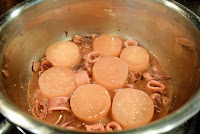The humble daikon takes on the flavor of calamari, becoming something gentle yet deeply aromatic. This is my mom's kind of dish, which I grow to like as I get older. While miso paste typically is the only main seasoning, modifying the dish to reduce sodium content by partially replacing miso with sakekasu sake lees, kurozu brown rice vinegar and shoyukoji soy sauce rice malt successfully results in a pleasantly mild flavor that lets you unwind after a busy day. If a bit of extra flavor is wanted, add grated ginger for a zesty punch or taka no tsume red chili pepper for picante heat.
125 calories; 12.2 g protein; 1.3 g fat; 11.4 g carbohydrate; 10.1 g net carbs; 155 mg sodium (with 50% reduced-sodium soy sauce); 163 mg cholesterol; 1.3 g fiber
<Ingredients>
200-250 g calamari (raw, before cleaning; 225 g in photo [140 g after cleaning])
For miso-flavored broth
200 cc water
1 small piece [3 cm square] konbu kelp
3 tbsp sake
1 tsp sugar
1/4 tsp sakekasu sake lees
1/4 tsp kurozu brown rice vinegar
2 tsp miso
1/2 tsp shoyukoji soy sauce rice malt
<Directions>
1.
Skin daikon and cut into 2-cm thick rounds (if using large daikon, half or quarter each round).
Clean calamari, and cut into 2-3 cm sections.
2.

In a pot, put all ingredients for broth, other than miso and shoyukoji soy sauce rice malt, and daikon, and bring to boil on low heat.
3.

When boiling, add calamari, place otoshibuta drop cover directly on top of ingredients, and simmer on medium low heat for 30 minutes.
4.
Add miso and shoyukoji, cover again, and simmer again for 5-10 minutes until broth is reduced to just enough to cover the bottom.
<Notes>
- If you already have kobudashi (konbu kelp infused water), start cooking daikon at higher heat -- medium low to medium is OK. Heating water at low heat at the beginning is to draw out umami from konbu in process 2 above.
- Sakekasu sake lees (sodium free) partially replaces miso paste.
- Shoyukoji soy sauce rice malt (minor sodium) also partially replaces miso paste (higher sodium) while adding some salty taste and sweetness. Kurozu brown rice vinegar (virtually sodium free) is added to mimic a salty sensation and to counter the sweetness from adding shoyukoji. These two help to create a more complex taste in the final dish but the difference is minor. If shoyukoji is not available, both shoyukoji and kurozu can be skipped.
- Nutrition figures above are based on an assumption that 80% of broth is consumed. Sodium content is calculated based on measurement of remaining broth in pot and bowls. I used miso paste that contains 580 mg sodium per 1 tablespoon (18 g).
- Miso paste's taste varies significantly by product. If using sweet miso, sugar may not be needed at all.







No comments:
Post a Comment